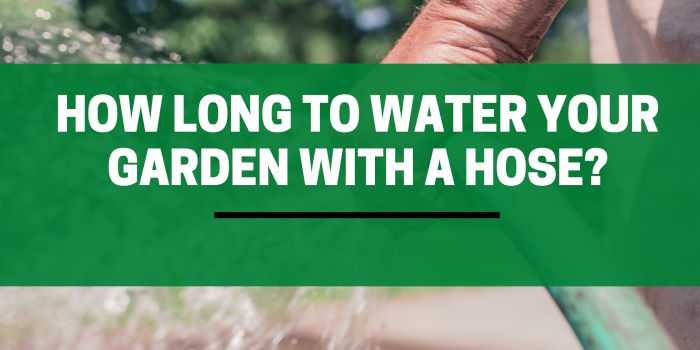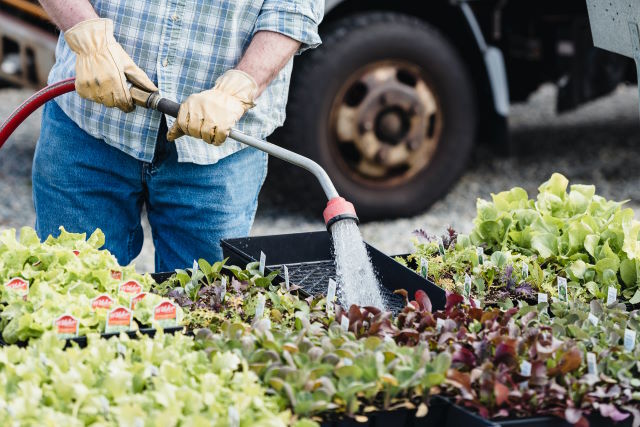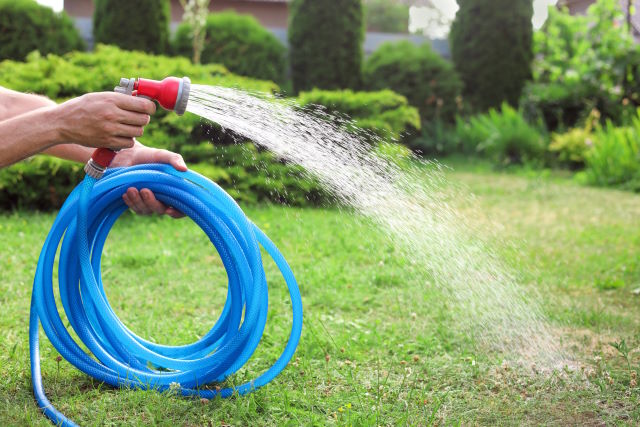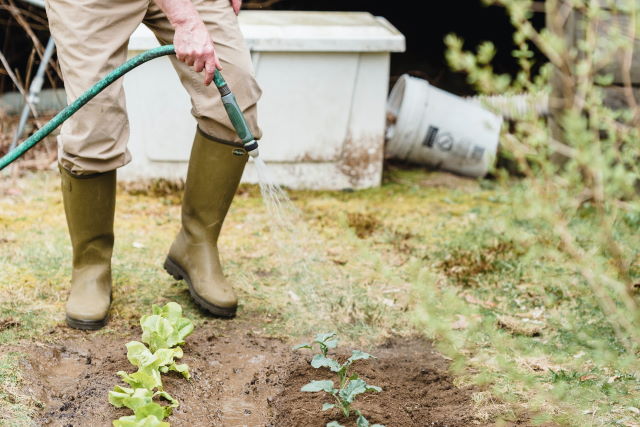Are you mystified by garden watering? Do you ever question whether you’re spending too much time or not enough showering your plants with the love of hydration?
By decoding the science behind it and understanding plant responses to different moisture levels, we aim to transform your green thumb into a horticulture hydration expert.
The ideal duration for watering your garden with a hose depends on various factors, such as the size of your plants and the weather conditions. As a general guideline, small flowers usually require 30-60 seconds of spray from a hose, while larger ones may need longer.
It is important to ensure that the moisture penetrates deeply into the soil to promote healthy root growth. Adjust your practices as vegetation matures and monitor the moisture levels in the soil to prevent overwatering.
Contents
Understanding Your Garden Watering Timing
Gardening is an enjoyable activity for many people, but it requires skill and knowledge to grow healthy, thriving plants. One of the essential aspects that gardeners need to understand is irrigation timing.
This can be the difference between a bountiful harvest and a disappointing yield.
Irrigation timing refers to how often and how long your plants receive moisture. Factors such as soil type, plant type, and size, climate, and weather conditions can affect the required frequency and duration. As such, understanding these factors can help you develop an appropriate irrigation schedule for your garden.
Factors Affecting Irrigation Timing
Several factors can affect irrigation timing and should be considered when determining how often and how long to water plants using a hose. The first factor to consider is the type of soil in the garden.
Soil with high clay content tends to retain moisture better than sandy soils. Therefore, gardens with sandy soils may require more frequent watering than those with clay soils.
Suppose you have a yard with sandy soil type planted with tomatoes and one with clay soil containing lettuce in raised beds. In that case, you may need to water the tomato bed for 20-25 minutes every day while the lettuce bed for five minutes every third day. The different soil types will impact drainage rates.
Another crucial factor affecting irrigation timing is the depth of your garden bed’s root system. Plants with shallow roots, such as lettuce or strawberries, will require less watering time since they don’t absorb moisture very deeply into the ground compared to trees or perennials.
The surrounding environment also plays a significant role in determining irrigation time. For example, hot and windy weather causes plants to lose moisture more quickly than cool and humid weather. As such, on hot summer days, you may have to increase the watering frequency or lengthen the duration.
Moreover, newly established landscapes require higher watering frequency than mature gardens. Young trees or shrubs with immature root systems haven’t yet developed sufficient depths to absorb water from deeper soil layers. Therefore, newly planted vegetation should be checked every few days for the first two weeks, and then establish a regular irrigation schedule.
Determining the moisture needs is similar to reading your body’s thirst; it’s best to drink when you are thirsty and not based on an arbitrary schedule. In other words, it’s better to monitor your plants’ moisture content than to maintain a rigid schedule.
While private gardeners are best advised to stick with watering manually using a hose manipulated by hand, larger spaces may find sprinkler systems more practical since they can easily cover the necessary area without their supervision and interference.
| Factors Affecting Irrigation Timing |
|---|
| Soil Type (Sand, Silt, Clay) |
| Depth of Garden Bed Root System |
| Environmental Factors (Temperature, Humidity) |
| Size of Plant/Type |
| Age of Plants |
Significance of Soil Type and Garden Depth
Before deciding on an irrigation plan, it’s vital to consider the soil type and depth. Sandy soils are generally easier to water since they drain more quickly, while those rich in clay drain slower; this means their watering requirements differ. A garden’s depth also influences irrigation timing – the deeper it is, the longer you should water for it to saturate the soil and reach the roots.
For example, a sandy soil garden around 6 inches deep can be watered for 5-10 minutes, whereas loamy soil with greater depth requires between 15-20 minutes. For clay soils that do not absorb water quickly and have a depth of about 8 inches, 25-30 minutes of watering using a hose is ideal.
Once you understand your soil type and garden’s depth, it’s time to select appropriate techniques to ensure sufficient hydration.
- When planning irrigation for a garden, it is crucial to consider the soil type and depth. Sandy soils drain quickly and require watering for shorter durations, while clay-rich soils drain slowly and need longer times. The depth of the garden also affects irrigation timing, with deeper gardens requiring more time for water to reach the roots. Understanding these factors allows you to select the appropriate techniques for effective hydration.
Effective Techniques for Using Hoses
Deep watering is better for plant roots than a shallow spray.
However, moving a hose around repeatedly can become tedious and cause moisture to be unevenly distributed. There are three effective techniques gardeners use when using hoses:
- Soaker Hoses: If you’re the kind of person who doesn’t want to stand outside holding a hose or move it every few minutes, a soaker hose can be an excellent solution. It uses pressure from the faucet to deliver water evenly over an extended period into surrounding soil via tiny holes or porous fabric covering its entire length.
- Root Watering: This technique involves using a specific tool designed to focus the hose’s flow directly onto the plant’s root system without harming it. By placing the nozzle near the base of each plant and letting water flow slowly, plants get proper hydration at their deepest levels without wasting any.
- Misting Sprayers: Instead of droplets, misting sprayers release a fine spray of water into the air. This technique is suitable for sensitive plants such as ferns and mosses or new seedlings that require gentle hydration.
For example, if you have a garden with shallow roots, using a soaker hose or a misting sprayer is what we recommend as they’re better at delivering even moisture to the surface. However, consider thoroughly saturating the soil, similar to rain, if your garden has deep roots; it will ensure moisture gets to those parts where it’s most needed.
Whichever method you choose, always make sure to monitor how long you’re watering and keep track of irrigation timing.
Here’s a crucial tip: It’s best to water early in the morning or late in the afternoon instead of mid-day when the sun can be intense and cause evaporation. It’s also essential to check local restrictions regarding wasting water during drought conditions.
Misting Sprayer Use and Benefits
Misting sprayers evenly disperse water droplets over foliage, creating a light mist that can hydrate plants more effectively than traditional methods.
These sprayers are ideal for seedlings and newly planted vegetation that require more delicate watering. The fine mist also provides an additional benefit of reducing evaporation and maintaining the moisture level in the air around the plant.
The downside, however, is that the mist spray may not be forceful enough to penetrate the soil and reach deeper roots.
Take, for instance, young tomato plants that require constant hydration but cannot withstand strong pressure on their leaves or fruit. Misting sprayers provide a gentle solution without damaging the plants’ structure while providing additional humidity levels in the process.
Managing Flow and Pressure
Using a hose requires managing both the flow and pressure to achieve optimal results.
When it comes to flow rate, a general guideline is to use timer intervals for different-sized plants. Small plants need only 30 to 60 seconds of watering per section of the garden, but larger ones may require several minutes. Move the hose around each section carefully to ensure proper coverage and good soil saturation levels.
Pressure management involves balancing water distribution in different areas while avoiding overflowing or soggy soil. Deep watering is crucial as it promotes root growth, which establishes stability within plants and lawns. To establish good habits, you should aim for moisture getting at least six inches beneath the surface area by using slower application methods like drip irrigation or soaker hoses.
Imagine drinking with a straw – some straws are long and thin while others are short and fat! Depending on what you’re drinking, you’ll want to switch up your straw. Understanding how different flow rates work best with various plants is essential.
Measuring devices that attach directly to hoses can help take the guesswork out of managing flow and pressure. Flow meters can detect how much liquid is flowing through the hose, while pressure gauges ensure you are irrigating at optimal levels based on soil type and plant water requirements.
Understanding how to manage water flow and pressure is crucial in optimizing garden irrigation.
Guidelines for Different Plants
Proper moisture management is essential for the health and growth of vegetation in your garden. However, different plants require different guidelines to thrive. For example, newly planted seedlings may require daily hydration for the first few weeks until their roots are established, whereas established trees need deep watering once a week.
Vegetables such as tomatoes, peppers, and beans need consistent moisture to grow healthy fruits or vegetables.
A good rule of thumb is to water them when the top 1-2 inches of soil feels dry. On the other hand, succulents store moisture in their leaves and stems; therefore, they require less frequent attention and should be checked weekly.
Similarly, flowering shrubs require regular moisture to encourage blooms, so consider monitoring the soil for its moisture levels at least once a week. Trees also need deep watering and may require longer irrigation times than smaller flowers.
Understanding these distinct needs will help you design an effective routine tailored to your garden’s needs.
Key Tips for Watering with a Hose
One of the most cost-effective ways to water your garden manually is by using a hosepipe. Here are some key tips for getting it right:
- Water early morning or late evening: When you water during cooler temperatures, like early morning or late evening, you reduce evaporation rates. If it is done under direct sunlight during hotter temperatures of the day, heat dries out the soil quickly.
- Water deeply: To ensure that the moisture reaches roots effectively, run your hose slowly at the base of each plant instead of quick sprays above leaves (which typically evaporate). Deep watering infuses more liquid into soils and allows it to percolate further below surface levels. Aim for up to 30 seconds’ worth of flow time for smaller plants and perhaps more for larger trees.
- Water less frequently: Instead of a shallow daily hosing down, do it less frequently but for a longer period. Aim to give your plants one inch of water per week, which approximates around 30 minutes of hose use per week depending on the flow rate.
- Use mulch: A layer of organic mulch helps retain moisture in the soil, reduces the chance of weed growth, and keeps the soil temperature stable. Apply a 2-3 inch layer of mulch around plants while leaving some space between the mulch and the plant’s base.
- Consider drip irrigation systems: While using a hosepipe is viable, it can be time-consuming and seems like too much work for larger gardens or those with many plants. You may want to opt for automated drip irrigation systems if you have such a garden.
A consistent schedule and technique may not be too appealing, but once you understand its benefits (like a better garden yield or improved plant health), it becomes an exciting routine worth investing time in.
Remember that there’s no exact science when watering your garden with a hosepipe. Understanding your garden’s needs and using these tips will help provide an optimally hydrated environment for all plants in your landscape.




